51. Sucre (Sucre, Bolivia)
From Potosi I shared a taxi 3 hours to Sucre. The taxi was only a bit more expensive than the bus, but I'd missed the bus by an hour cos I'd been told the wrong departure time.
Sucre is the official capital of Bolivia, but La Paz is where the Government sits which makes it the Capital in most people's books (including the Bolivians). And what a beautiful city it is. The downtown area has preserved its colonial-era colour scheme of white buildings with terracota roofs.
The climate was pleasant, because of the 2500m altitude it has a year-round spring feel (although it was a bit wet during my visit). Evidentally it's popular with gringos too, there were a couple of bars owned by Dutchmen now living here. Sucre itself doesn't have too many activities apart from a lot of museums. Although the Dutch-owned bars such as Joyride Cafe provide hiking and mountain biking tours, as well as being backpacker favourites with good menus and a big screen for movies.
I met up with Gabriel, an Argentine backpacker from Buenos Aires I'd first met in Uyuni and then Potosi, and we spent a few days chilling out visiting museums. We also timed our visit for the weekend, and found the clubs to be good value. Lots of hot girls too, better than the south! Did I mention the city's clean? It so doesn't feel like the Bolivia I expected, it feels more like Argentina or Chile even. And great food too.
A great place to hang out was the central plaza, where the whole town seems to meet. Beautiful gardens and plenty of benches, a great spot just for people watching. Unfortunately I couldn't get a decent photo of it, but here's a photo of one of Sucre's smaller plazas.
A few kilometres from Sucre is a quarry, where 40 years ago the quarry workers discovered a set of Dinosaur tracks. The site is one of the largest collection of dinosaur footprints in the world, and although it sounded like a tourist trap (or fraud) we went along on the cheap tour.
It was actually quite impressive, millions of years ago when the world was still two continents the area had a lake, at which dinosaurs evidentally drank. A volcanic eruption occured and the dinosaurs in the area were presumably wiped out, but their footprints in the mud were preserved by the layer of volcanic ash. The footprints were from a variety of dinos, from Brontosauruses to everyone's favourite the Tyrannosaurus Rex, whose claws had left scratches indicating it had been running through the mud (chasing something?). The tracks were along a long, tall, gray wall, a wall which was created by the pressure from the plates colliding. The area was still owned by the quarry, but they'd stopped work on the wall when the tracks were first discovered. They say there's over 5000 prints at the moment, but more are discovered all the time as the wall erodes, unvieling more prints.
Another unexpectedly interesting stop was the Indigenous textile museum, which displayed the 6 different styles of textiles weaved by the indigenous tribes of the region near Sucre. They weave mostly wallhangings but formerly weaved skirts or ponchos. A largish wallhanging (0.7m by 1.5m) is up to 3 months of fulltime work!
In all I spent 4 days in Sucre, but I could easily have spent longer, or even live there, like the Dutch bar-owners. Being a large city, it also has a fair amount of beggars, mostly very old women with incredibly weathered faces, in traditional Spanish colonial-era dress.
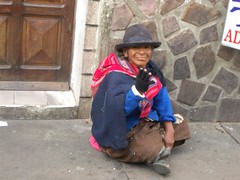
Street beggar
Still, Sucre really exceeded my expectations. A lot of Argentinans in particular told me bad things about their northerly neighbour (Bolivia), that it's dirty, uncivilised, that men piss in the street, etc. Some Argentine friends that backpacked through on the way to Peru refused to eat anything, such was their fear of Bolivian food poisoning. Other friends told me of constant diarrea throughout their stay. To me some of the smaller cities are a little undeveloped, but the larger cities are as clean as any others in South America. Sucre is one of the cleanest I've seen. The food is great, and cheap. For 8Bs in a cheap restaurant (US$1) you can have a set lunch of soup, a salad, a main, and a dessert, and you'd be eating well, as well as the locals. For double or triple that you can eat like kings, picking whatever from the menu of the nicer restaurants. And so far, no problems at all with food poisoning in the 2 weeks I've been here, touch wood.
Sucre is the official capital of Bolivia, but La Paz is where the Government sits which makes it the Capital in most people's books (including the Bolivians). And what a beautiful city it is. The downtown area has preserved its colonial-era colour scheme of white buildings with terracota roofs.
The climate was pleasant, because of the 2500m altitude it has a year-round spring feel (although it was a bit wet during my visit). Evidentally it's popular with gringos too, there were a couple of bars owned by Dutchmen now living here. Sucre itself doesn't have too many activities apart from a lot of museums. Although the Dutch-owned bars such as Joyride Cafe provide hiking and mountain biking tours, as well as being backpacker favourites with good menus and a big screen for movies.
I met up with Gabriel, an Argentine backpacker from Buenos Aires I'd first met in Uyuni and then Potosi, and we spent a few days chilling out visiting museums. We also timed our visit for the weekend, and found the clubs to be good value. Lots of hot girls too, better than the south! Did I mention the city's clean? It so doesn't feel like the Bolivia I expected, it feels more like Argentina or Chile even. And great food too.
A great place to hang out was the central plaza, where the whole town seems to meet. Beautiful gardens and plenty of benches, a great spot just for people watching. Unfortunately I couldn't get a decent photo of it, but here's a photo of one of Sucre's smaller plazas.
A few kilometres from Sucre is a quarry, where 40 years ago the quarry workers discovered a set of Dinosaur tracks. The site is one of the largest collection of dinosaur footprints in the world, and although it sounded like a tourist trap (or fraud) we went along on the cheap tour.
It was actually quite impressive, millions of years ago when the world was still two continents the area had a lake, at which dinosaurs evidentally drank. A volcanic eruption occured and the dinosaurs in the area were presumably wiped out, but their footprints in the mud were preserved by the layer of volcanic ash. The footprints were from a variety of dinos, from Brontosauruses to everyone's favourite the Tyrannosaurus Rex, whose claws had left scratches indicating it had been running through the mud (chasing something?). The tracks were along a long, tall, gray wall, a wall which was created by the pressure from the plates colliding. The area was still owned by the quarry, but they'd stopped work on the wall when the tracks were first discovered. They say there's over 5000 prints at the moment, but more are discovered all the time as the wall erodes, unvieling more prints.
Another unexpectedly interesting stop was the Indigenous textile museum, which displayed the 6 different styles of textiles weaved by the indigenous tribes of the region near Sucre. They weave mostly wallhangings but formerly weaved skirts or ponchos. A largish wallhanging (0.7m by 1.5m) is up to 3 months of fulltime work!
In all I spent 4 days in Sucre, but I could easily have spent longer, or even live there, like the Dutch bar-owners. Being a large city, it also has a fair amount of beggars, mostly very old women with incredibly weathered faces, in traditional Spanish colonial-era dress.

Street beggar
Still, Sucre really exceeded my expectations. A lot of Argentinans in particular told me bad things about their northerly neighbour (Bolivia), that it's dirty, uncivilised, that men piss in the street, etc. Some Argentine friends that backpacked through on the way to Peru refused to eat anything, such was their fear of Bolivian food poisoning. Other friends told me of constant diarrea throughout their stay. To me some of the smaller cities are a little undeveloped, but the larger cities are as clean as any others in South America. Sucre is one of the cleanest I've seen. The food is great, and cheap. For 8Bs in a cheap restaurant (US$1) you can have a set lunch of soup, a salad, a main, and a dessert, and you'd be eating well, as well as the locals. For double or triple that you can eat like kings, picking whatever from the menu of the nicer restaurants. And so far, no problems at all with food poisoning in the 2 weeks I've been here, touch wood.
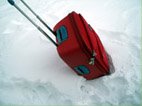
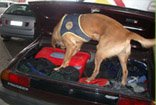
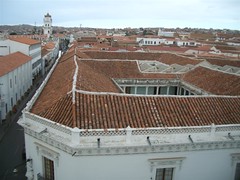
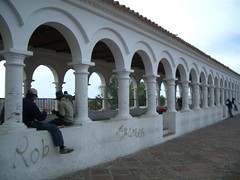
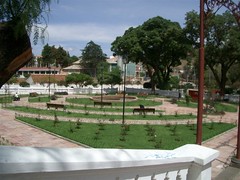
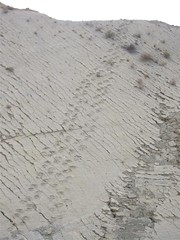
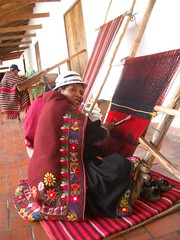
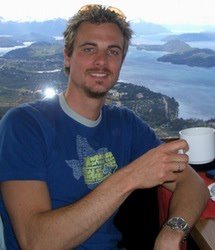


4 Comments:
Damn, I was gonna ask if Sucre had anything to do with sugar, but I guess not.
Bolivia seems pretty cool, a place I knew almost nothing about until your travels.
Ta,
Ed.
By slaggybuttonit, at 4:09 pm
slaggybuttonit, at 4:09 pm
zzzzzzzzzzzzzzzzzzzzzzzzzzzz
By Anonymous, at 2:10 pm
Anonymous, at 2:10 pm
I'd say that Sucre sounds like a place it could be good to stop at for a while. Could you fly (p.g) there?
By Anonymous, at 6:20 pm
Anonymous, at 6:20 pm
Hey Bruce
Yep, in fact one of the aforementioned Dutch bar owners offers a paragliding tour. I don't know how much it costs.
I just visited Copacabana which is amazing, and there's tandem paragliding there too for I think 280Bs which is about US$35.
As for pissing in the street, well I guess drunk guys do that all over the world. I didn't see much of it until I got to La Paz, and it wasn't a big deal. What was a big deal was that no restaurant or hotel I stayed in had toilet paper in the bathrooms (nor a bidet or other cleaning device). And most of the public toilets you have to pay to use (if you can find one), hence the pissing in the streets I suppose.
By mattyboy, at 3:54 am
mattyboy, at 3:54 am
Post a Comment
<< Home